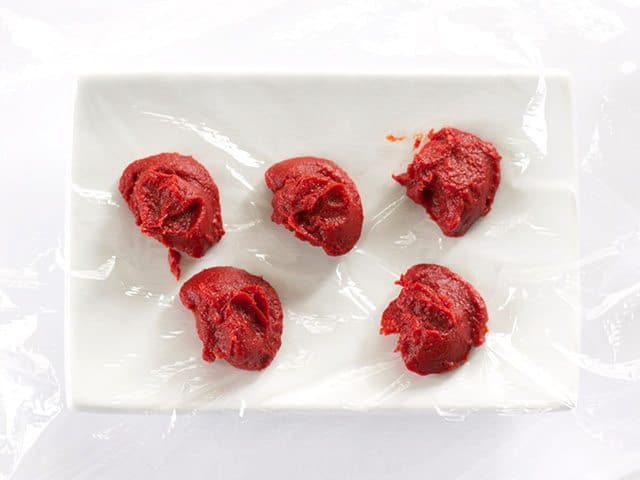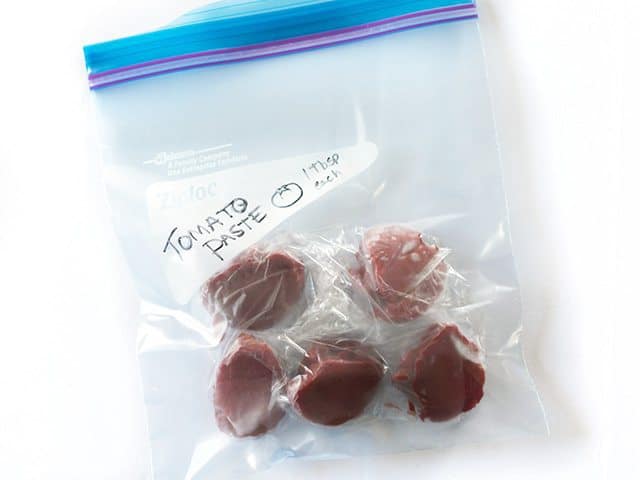Happy Friday! I’m sure you’re busy getting your big Friday night plans together, so I wanted to leave you with this quick how-to (new recipe tomorrow). If you’ve followed Budget Bytes for a while, you already know that I always freeze my leftover tomato paste. Why? Because, despite coming in a super small can, I rarely use the whole thing in one recipe. Instead of tossing the rest of the can, I keep the leftovers in the freezer, so I don’t have to buy a new can for the next recipe.
It sounds easy enough, but after freezing my tomato paste for years I’ve developed a better method for freezing and storing my leftover tomato paste. I used to just shove it in a freezer bag, squeeze it all down to the bottom, and pop it in the freezer. But that presented problems the next time I wanted to use it. How do you measure a frozen clump of tomato paste? What if I only wanted to use part of the clump? I would end up breaking off a chunk, never truly knowing how much I was using.
So this tutorial is for all of you who have been throwing away their partially used cans of tomato paste and those who have been just spooning it into a freezer bag like I used to. This is what you should be doing with your leftover tomato paste, and it’s as easy as 1-2-3.
How to Freeze Tomato Paste – Step by Step Photos
Step 1: Prepare the Tomato Paste
Measure your leftover tomato paste into 1 tablespoon dollops and place them on a plate or baking sheet covered in plastic wrap. The plastic wrap keeps the paste from sticking to the plate while they freeze and will be used to wrap the tomato paste within the freezer bag. Make sure the dollops are not touching, so they freeze individually and are easy to separate into 1 tablespoon servings later. Plate the plate or baking sheet into the freezer uncovered for 2-3 hours, or until the dollops are frozen solid.
Step 2: Transfer the Tomato Paste
Freezing the tomato paste uncovered on a flat surface helps them stay separated into individual lumps, but leaving them like that for an extended period will cause them to dry out and get freezer burn. So, as soon as they are solid you need to transfer them to an air-tight container for long term storage. I used a quart sized freezer bag, which I made sure to label with the contents. Just lift the plastic wrap up off the plate and wrap it around the balls and place the package inside the freezer bag. Since the balls are already frozen solid, they won’t fuze together if you just wrap them up in the plastic.
Step 3: Freeze for Long Term Storage
Squeeze as much air out of the bag as possible before sealing, then return it to the freezer. Now you can just grab one or more lumps of tomato paste as needed for your next recipe! Because tomato paste has such a low moisture content to begin with, I find that they last quite a while in the freezer. I tend to use tomato paste often, so I’ve never had any in the freezer longer than 4-5 months, but it’s always maintained its quality up to that point.
So how about that? Pre-measured tomato paste ready and waiting to be used in your freezer. Because the lumps are small, I usually just drop them into whatever soup or sauce I’m using it in, straight from the freezer. They melt and stir in within moments.
I hope you found this quick tip useful! Have a great weekend!




I use ice cube trays which I first spray with no stick, usually coconut oil spray, and then fill each section with the paste. Depending on the size of each section, it usually holds 1 T of paste. Once frozen I simply rinse the back of the ice cube tray to loosen the product and pop it out into a bowl and then place in my Food Saver resalable zipper bags. When I need for cooking I just pull out how ever many I need and then reseal to put back in freezer.
I was having an issue with this as my Dad makes “metal can” figures and was always emptying my SMALL cans and then what the heck do I do….did not think about freezing….only thing I would add is a Date…as I do freeze just about everything else and work my hardest to use FIFO on a steady basis. Thanks for your information. ttfn
This is close to my method, which is easier and is one less step. I just rip off squares of plastic wrap and place the fresh tablespoonful dollops in that and twist/fold over. Then I just throw all the little balls into the freezer bag. No pre-freezing. No ice cube trays to clean.
http://baconfatte.com/tomato-paste-tips-storage/ Like this but without the whole careful and trimming excess part because who cares!
This is brilliant!
What I do is, I put the remaining paste into an air tight container, cover it with olive oil and toss it into the fridge. If you make sure that the oil covers all the surface, it can last several weeks in the fridge without molding.
I also make sure to use a clean spoon to avoid contamination. And ensure the lid is tight.
But I definitely will start freezing it this way when I have enough left over.
Hey that’s clever- what do I make with tomato paste that doesn’t have olive oil in it already anyway? I’m going to try that.
Thanx for that! You have no idea how often I am trying to weigh a jar of tomato paste 😱 Thank you for your recipes and great ideas for what I should do to save myself the heartache of throwing out stuff!
Just goes to show, I should read it not just trust that the speaking a message would be right. I’m not going to wait a jar I am tired of throwing Upwey a jar because it’s got mould on it. No longer thanks to you!
Thanks for the tip! I’m making enchilada sauce tonight and I’ve never thought about freezing leftover tomato paste. Great idea!
This is brilliant!
That said, during a brief time living overseas, I got used to buying tomato paste the only way it was available – in a tube, much like toothpaste. It was great – squeeze out what you want, and put the tube back in the fridge indefinitely.
When I got back to the US, it took me a while, but I was able to find a few stores that carry tomato paste in a tube, and unless I’m making something that requires a whole can, like a giant pot of chili, I splurge on the tube. Not sure if it is entirely budget friendly, but it is convenient.
As others have said, this works with other things too. My favorite is portioning leftover gravy after it is cold and congealed and freezing it. I use a #8 scoop. It = 1/2 cup. Put the scoops on a plate and freeze. Drop them a Baggie! Take out what you need. You can use them as gravy or add to soups for flavoring/thinking etc.
I do this too! It’s great to be able to grab a tablespoon without opening a can. But I’m super lazy so I just take a spoonful and stick it in a baggie, then use my hand outside the bag to slide the paste off the spoon ans into the bottom corner of the baggie. Next spoonful goes to the other corner, next one somewhere in the middle, etc. When it’s all in, I close the bag, squeeze out the air, then use my hand on the outside to make sure none of the blobs are touching. Took much more time to describe than it does to do! And no extra dishes!
Ha! I get what you’re saying, though! That’s a great technique. Very simple. :D
Thank you for this! I had never thought to freeze tomato paste (then again, I’m not creative at all when it comes to freezing stuff). I also have silicone ice cube trays handy that I never use! (not even for ice cubes!)
I actually just dollop any extra into silicone ice cube tray, freeze overnight, and then pop into another freezer container – super simple
BRILLIANT.
When I find myself with leftover tomato paste, I just eat what’s left with a spoon. Right out of the can.
What? It’s a vegetable!
Wow! :D
I’m sooooo glad I am not the only one who does this. I think tomato paste is delicious on its own.
My husband spreads the tomato paste on bread, adds basil, garlic and cheese, and toasts in the toaster oven for mini “pizzas”. He actually gets disappointed if there is none leftover from the can!
You can buy nice tomato paste in tubes also.
I find that it actually adds a lot to homemade veggie broth. I just through the leftover tomato paste into my veggie scrap bag in the freezer and when I have enough veggie scraps, I make broth.
Oh my God, I’m embarrassing. I meant throw, not through.